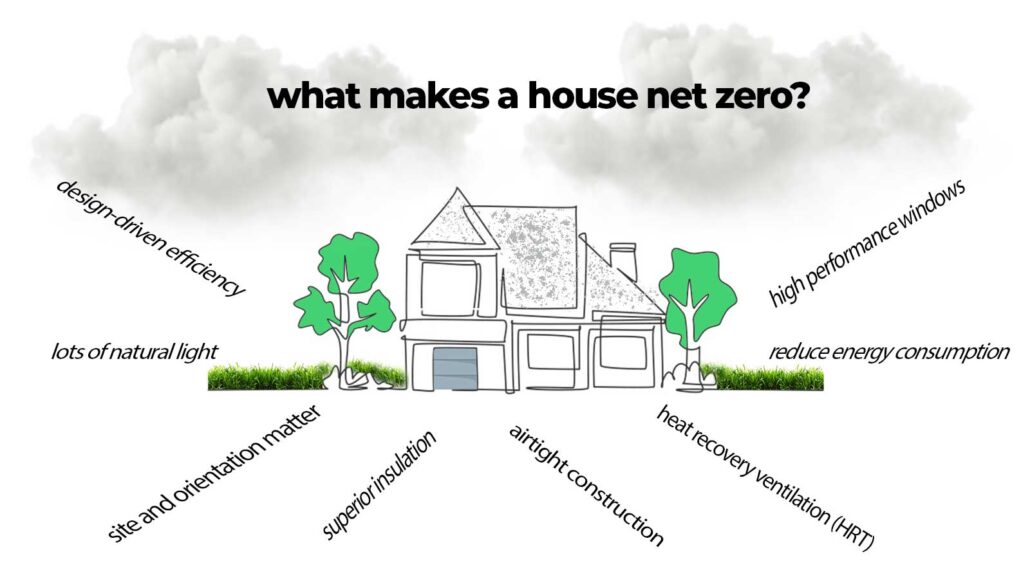What Makes A House Net Zero
Reaching Net Zero means a home produces as much energy as it consumes over the course of a year. But how is that even possible? It starts with smart, efficient design—often inspired by Passive House principles—and the careful integration of sustainable technologies and building practices.
If you’re wondering where to begin, two great resources are our blogs:
What Is A Passive House
What Makes A House Sustainable
Both offer insight into the components that contribute to creating high-performance, energy-efficient homes. But let’s break it down even further and look at the key features that help a house become Net Zero:
Net Zero Components
Lots of Natural Light
The placement and design of a Net Zero home prioritize natural daylight. South-facing windows (in our Northern Hemisphere climate) help maximize solar gain, reducing the need for artificial lighting during the day and helping to passively warm the home in colder months.
Airtight Construction
A truly Net Zero home must be airtight. This means minimizing air leaks and drafts that can lead to heat loss in the winter and unwanted heat gain in the summer. Airtight construction ensures stable, comfortable indoor temperatures year-round and reduces the load on heating and cooling systems.
High Performance Windows
Triple-pane windows with insulated frames help maintain indoor temperatures by reducing heat transfer. They also improve acoustic comfort and eliminate cold spots near window surfaces. These windows play a big role in a home’s energy efficiency and overall comfort.

Superior Insulation
Extra-thick insulation in the roof, walls, and floors dramatically reduces the amount of energy required to heat or cool a space. In a Net Zero home, insulation is continuous and carefully installed to avoid thermal bridging—a weak point in the building envelope where heat can escape.
Heat Recovery Ventilation (HRV)
A heat recovery ventilation (HRV) system is essential in an airtight home. It provides a continuous supply of fresh air without losing the heat (or cool) that’s already been generated inside. The HRV captures warmth from outgoing air and transfers it to the incoming fresh air, improving indoor air quality while saving energy.
Reduced Energy Consumption
Thanks to airtightness, insulation, efficient systems, and thoughtful design, a Passive or Net Zero home can consume up to 90% less energy than a traditional home. These homes are also often powered by renewable sources, such as rooftop solar panels, further reducing their environmental footprint.
Site and Orientation Matter
The location and orientation of the home are critical. A well-designed Net Zero home takes advantage of the sun’s path, local climate conditions, and natural shading to minimize energy use. Even landscaping can play a role—trees can help block harsh summer sun or reduce wind exposure in winter.
Design-Driven Efficiency
Net Zero homes are not just about adding “green” components—they are about designing with intention from the ground up. Every decision, from window placement to material choice, plays a role in balancing comfort, sustainability, and performance.
In Conclusion
A Net Zero home isn’t just an eco-buzzword—it’s a future-forward solution for comfortable, low-impact living. With Passive House principles at its core and sustainability woven into every layer, a Net Zero home proves that efficiency and design can go hand in hand. Want to learn more about building or renovating toward Net Zero? Get in touch—we’d love to help you bring your vision to life.
At GNAR Inc we are passionate about creating sustainable homes, let us know how we can help you bring your dream house to life. Call us at 604.962.1611 or email info@gnarinc.com for more information.
Net Zero In Action

Lots of Natural Light
A Passive House will be situated to
capture as much daylight as possible

Reduced Energy Loss
Realized by utilizing extra thick
insulation in the roof, walls and floors


Airtight Construction
Which allows for year round comfort
and consistent temperatures by
eliminating drafts

Reduced Energy
Consumption
A Passive House consumes up to 90% less energy than traditionally
built homes


Heat Recovery
Mechanical ventilation achieves highly
efficient heat recovery

High Performance
Windows
Window frames and glazing (triple pane) contribute to reduced energy loss

